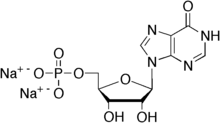Disodium inosinate
 | |
| Names | |
|---|---|
| IUPAC name
Disodium [(2R,3S,4R,5R)-3,4-dihydroxy-5-(6-oxo-3H-purin-9-yl)oxolan-2-yl]methyl
phosphate[1] | |
Other names
| |
| Identifiers | |
3D model (JSmol) |
|
| ChemSpider | |
| ECHA InfoCard | 100.022.860 |
| E number | E631 (flavour enhancer) |
PubChem CID |
|
| |
| |
| Properties | |
| C10H11N4Na2O8P | |
| Molar mass | 392.17 g·mol−1 |
Except where otherwise noted, data are given for materials in their standard state (at 25 °C [77 °F], 100 kPa). | |
| Infobox references | |
Disodium inosinate (E631[2]) is the disodium salt of inosinic acid with the chemical formula C10H11N4Na2O8P. It is used as a food additive and often found in instant noodles, potato chips, and a variety of other snacks. Although it can be obtained from bacterial fermentation of sugars, it is often commercially prepared from animal sources.[3]
Use as a food additive
Disodium inosinate is used as a flavor enhancer, in synergy with monosodium glutamate (MSG) to provide the umami taste. It is often added to foods in conjunction with disodium guanylate; the combination is known as disodium 5'-ribonucleotides.
As a relatively expensive product, disodium inosinate is usually not used independently of glutamic acid; if disodium inosinate is present in a list of ingredients, but MSG does not appear to be, it is possible that glutamic acid is provided as part of another ingredient or is naturally occurring in another ingredient like tomatoes, Parmesan cheese, or yeast extract.
Origin
Disodium inosinate is generally produced from meat, including fish. Though it is normally a non-vegetarian product, it also may be produced from tapioca starch without any animal products involved in the production. The producer can provide information on the origin and it is in some cases labeled as "vegetarian" in ingredients lists when produced from plant sources.[4][5]
Toxicology and safety
In the United States, consumption of added 5'-ribonucleotides averages 4 mg per day, compared to 2 g per day of naturally occurring purines. A review of literature by an FDA committee found no evidence of carcinogenicity, teratogenicity, or adverse effects on reproduction.[6]
In 2004, disodium inosinate was removed from the food additive list by Codex Alimentarius Commission[7] (but it is still mentioned on the last (2009) codex alimentarius list).[8]
See also
References
- ↑ CID 20819 from PubChem
- ↑ Food Standards Australia New Zealand. "Food Additives- Numerical List". Archived from the original on 25 June 2009. Retrieved 2 December 2009.
- ↑ "Vegetarian Society - Fact Sheet - E Numbers - Derived from both plant and animal sources, Animal derived carriers". www.vegsoc.org. Retrieved 2016-10-09.
- ↑ "E-numbers : E631 : Sodium inosinate". Food-Info.net. 1998-09-27. Retrieved 2013-02-04.
- ↑ "All PepsiCo India food products and their ingredients are 100% vegetarian" (PDF). www.pepsicoindia.co.in.
- ↑ Disodium 5'-guanilate and Disodium 5'-inosinate, K. Ekelman and K. C. Raffaele, Additives Evaluation Branch, Division of Health Effects Evaluation, Center for Food Safety and Applied Nutrition, Food and Drug Administration, Washington, DC, USA and other
- ↑ Codex Alimentarius Commission. "Report of the 36th Session of the Codex Committee on Food Additives and Contaminants" (PDF). Retrieved 2 December 2009.
- ↑ "Class Names and the International Numbering System for Food Additives". Archived from the original on 5 September 2010. Retrieved 7 August 2010.